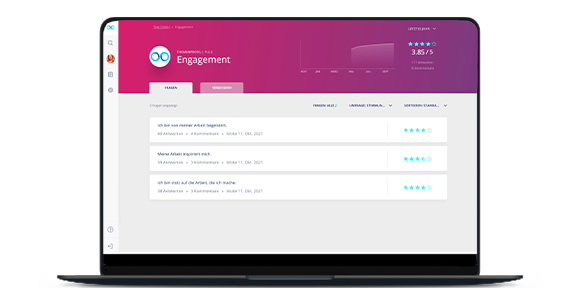
Pragmatische Zielsetzung mit OKRs
13.09.2022
Christian Kaller
Every good goal-setting system has the overriding guideline of translating the organization's goals into concrete action and thus materializing them. A goal system focuses the energy of all actors in the company and coordinates - ideally - both individual work and teamwork.
Among the various goal methods, OKRs ("Objectives & Key Results") have enjoyed increasing international attention since John Doerr established them at Google. The focus is on transparency, coordination and teamwork. That's why OKRs are a particularly effective complement to the requirements for successful collaboration that have changed in the wake of New Work and digitization. OKR management has also proven to be surprisingly flexible when used in a wide variety of organizational forms. More information on the history and use of the OKR method can be found here.
However, it is also true for OKR Management that not every element of the method always fits every organization. Under the heading "Pragmatic Goal Setting", we would therefore like to take a look at the most important elements of the OKR method: Cascading, Coordination and Transparency. These three elements can be applied either "by the book" according to the guidelines of classical OKR management. Alternatively, minor changes can ensure fit with one's own organization and overall goals. Quite pragmatically.
What is possible, and what needs to be considered?
Cascading - for a clear division of individual goals.
Ideally, every good goal-setting system starts with the question: What do we want to achieve as an organization? Based on this prioritization, a set of goals (=objectives) is then defined. The next step is to divide them into divisional goals, departmental goals, team goals and (if desired) individual goals. On the one hand, this ensures that the energy of the entire organization is directed in the desired direction. In addition, the development of goal cascading itself provides a helpful translation from strategy to operational implementation.
Important at this point: Decide in advance on the respective cascading depth and cascading hierarchy.
The cascading depth
The cascading depth refers to the different levels of the organization and associated goals. Do the goals serve more of a communication of the organization's mission? Should organizational goals be broken down to team goals? Or should each individual employee be given individual goals? The answers to these questions can be completely different depending on the organization.
Example 1: A company in economic difficulty with a high degree of centralization relies on all employees pulling together in tightly defined guardrails. Here, "cascading" the goals down to the individual employee, including connection to the company's internal performance management system, can make sense.
Example 2: A gaming studio with decentralized teams and a focus on creativity might set the guidelines less tightly and cascade the goals only down to the team level, deliberately leaving room to achieve the goals at the individual level.
The cascading hierarchy
The cascading hierarchy describes the relationship of the individual cascading levels to each other. Classically, the Objectives are connected in a tree structure: The progress of individual Team Objectives pays into the progress of the Organization Objective with or without intermediate levels.
Alternatively, the subdivision into the different levels is left without the direct link. In other words, the team objectives are aligned with the organizational objective in terms of content and marked as team objectives, but do not have a 1:1 link to the progress of the organizational objective beyond the relationship in terms of content.
In reality, this option often makes more sense. A cascading tree relies on each level being maintained cleanly at all times so that the system covers reality at each goal level. Anyone who has worked with target systems in reality knows how difficult this can be. A loose coupling also has the advantage that different success KPIs can be applied between the levels of the OKRs. This is because it is not always possible, for example, to translate sales targets at the organizational level outside of sales teams 1:1 into the necessary success variables for teams. For the example organization 1 above, however, this close coupling could still make sense.
Coordination - for more overview & clear responsibilities
In addition to the control component, target systems always have a coordinating element. This is especially true when using digital goal management software such as LoopNow's OKR module. By gaining visibility into progress, capacities and milestones achieved, employees can align their own actions with the requirements of their environment. Among other things, it is important to whom goals are assigned. In concrete terms: Who is involved in the achievement of an individual objective? In practice, this means at the various levels:
Individual employees can record their own progress and share it with their manager. In this case, they alone are responsible for the success or failure of the objective. This allows for a link to individual performance management (though not always useful).
If several team members are working on the achievement of a team objective, OKR software can help to coordinate the collaboration. Through the continuous documentation of progress, blockers and free capacities become visible on the one hand, and on the other hand, weaknesses can be uncovered and eliminated in the sense of a learning organization for continuous improvement.
At the organizational level, the objectives primarily ensure the coordination of entire areas and departments. Indirectly, however, they can also influence the actions of all employees if they are visible.
To revisit the example of our two organizations from above, Organization 1 (centralized, tight control needed) would possibly consider Objectives strongly at the individual level to identify top performers and ensure maximum effectiveness of all employees. Organization 2 (decentralized, focus on creativity) breaks goals down to team level only and works more with team level incentives rather than individual bonuses.
Transparency - for visibility & measurability
The "classic" OKR method makes all goals visible organization-wide. This has several advantages: Silo thinking is avoided at the organizational level. It is comprehensible for everyone how their work impacts the larger whole of the organization and its mission. Inefficiencies are avoided by exposing redundancies. And more generally, an appreciation for the work of other teams can be fostered when successes are made visible across teams.
But here, too, there may be good reasons why objectives at individual levels should not be made visible to the entire organization.
Bottom Up: If individual objectives are coupled with a performance management component, it can of course make sense to keep the achievement of objectives and goal setting between the manager and the employee.
Top Down: Especially in times of economic uncertainty, it can make sense not to make goal achievement publicly available at the corporate level without context. The focus here is on "context." Not everything always goes according to plan, and classification by top management can help keep communication from getting out of hand when revenue targets are missed, for example.
Of the two example organizations above, organization 1 would probably be more likely to rely on more limited visibility than organization 2.
Frequency - for dynamic adjustments along the way
For the sake of completeness, let's also briefly address the issue of frequency. The OKR method says: goals should be created and redefined on a quarterly basis. This high frequency ensures good traceability of goal achievement and forces goals to be broken down into smaller, more manageable packages. At the same time, it provides a good balance between goal setting effort and momentum. Of course, you can also tweak the timing here, setting corporate goals at 6 months, for example, but adjusting team goals on a quarterly basis.
We recommend an iterative approach: operations should "groove" on the goal-setting cycles that suit them - in our experience, you quickly notice what works well. One thing is clear to us, however: goal setting over an entire year with a check-in at the beginning and end of the year are no longer appropriate. Target systems need to keep up with the dynamics of the organization's business environment - and these dynamics will not slow down again.
Digital OKR Management Software as Enabler
OKR Management unfolds its full potential only with a digital goal management solution that both makes progress visible and enables collaboration (e.g., on Team Objectives). No matter which system I choose, ideally it is flexible enough to adapt to my organization. This is the reason why we at Loopline have kept our software for OKR management, LoopNow, as flexible as possible. Team goals custom-fit and adaptable for the entire organization, or just make your own team visible? Check. Share individual goals only with your own manager? Check. Work together on a Key Result and document progress transparently? Check.
Because: we firmly believe that systems should adapt to organizations, not the other way around. At the same time, any goal management software is only as good as it is maintained. That's why we've radically lowered the hurdle: Every Objective can automatically play out "progress maps" at customizable update intervals - one click from the mail, and I can adjust exactly the Key Results I'm working on. Quite pragmatically.




